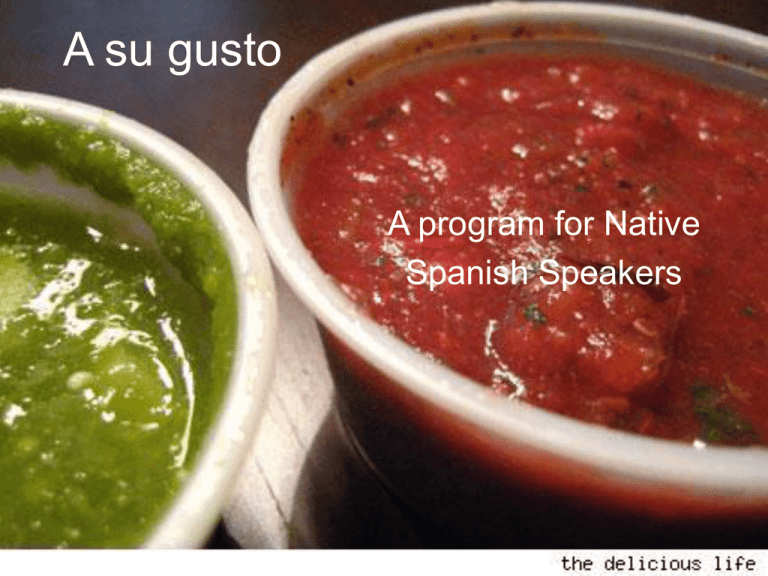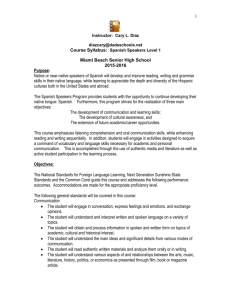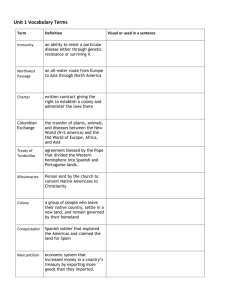A su sabor - Harrisonburg City Public Schools
advertisement

A su gusto A program for Native Spanish Speakers Objectives Encourage the formation of classes for Native and Heritage Spanish Speakers Describe the program at Harrisonburg City Public Schools for Native and Heritage speakers of Spanish. Identify attitudes and perspectives that have proven beneficial. Provide resources and ideas. Where You From? by Gina Valdés Soy de aquí y soy de allá from here and from there born in L.A. del otro lado y de éste crecí en L.A. y en Ensenada my mouth still tastes of naranjas con chile soy del sur y del norte Crecí zurda y norteada cruzando fron teras crossing San Andreas tartamuda Y mareada where you from? soy de aquí soy de allá I didn’t build this border that halts me the word fron tera splits on my tongue Testimonials - Camila Pandolfi Testimonials - Alejandra Gutierrez Definitions Native Speaker Hispanohablante Heritage Speaker Harrisonburg City Public Schools - Diversity HCPS has one of the highest Limited English Proficient (LEP) percentages in Virginia. HCPS is a small division of approximately 4,400 total students 38% of those students are LEP. 48 different countries and 52 different languages are represented. Of our LEP population, 62% was born in the United States. 50% of our kindergarteners through 3rd graders are LEP. Harrisonburg City Public Schools - Native Languages 7% 2% 4% 4% Spanish 6% Russian Kurdish Arabic Otomi Other 77% History of our program Native Spanish speaking students signed up for Spanish classes – Regular Spanish classes did not met their needs. – Students and teachers were frustrated. – Native Speakers often received bad grades and lost motivation. – Native Speakers genuinely wanted to study Spanish ESL learners had no classes that challenged them to think critically and analytically. Latinos were/are among the highest in dropout risk. History of our program adding classes 200 NS 1 180 NS 2 160 NS 3 AP 140 totals 120 100 80 60 40 20 0 NS 1 19992000 20002001 20012002 20022003 20032004 20042005 20052006 20062007 20072008 20082009 20092010 20102011 23 47 20 16 49 50 44 73 38 63 77 88 7 8 19 28 36 41 26 59 58 18 14 14 19 27 43 90 123 93 108 163 189 NS 2 NS 3 AP totals 23 47 20 23 57 69 History of our program number of sections 12 10 8 NS 1 NS 2 6 NS 3 AP totals 4 2 0 1999- 2000- 2001- 2002- 2003- 2004- 2005- 2006- 2007- 2008- 2009- 20102000 2001 2002 2003 2004 2005 2006 2007 2008 2009 2010 2011 What we have today -- classes Harrisonburg High School – Spanish for Native Speakers 1 • Assumes a 3rd grade reading/writing level in Spanish – Spanish for Native Speakers 2 • SNS 1 is required – Spanish for Native Speakers 3 AP • Prepare for the Spanish AP language exam – Spanish Literature AP (independent study) What we have today -- classes Three teachers who currently teach at least one Spanish for NS class – two Native Speaks – one hispanohablante ESL offers Spanish literacy. World Language Studies – Rosetta Stone based What we have today -- classes Middle schools – Spanish 1 for Heritage Speakers • Regular Spanish 1 text and material, but students are only native or heritage speakers • Students receive high school credit for Spanish 1 • Teacher recommends student for Spanish 2 or NS 1 – Spanish for Native Speakers • Semester course with no high school credit Elementary school – Spanish/English bilingual program • first kindergarden class this year What we have today -challenges Placement of students in the appropriate level – Spanish ability – Confidence in their abilities – Matching abilities with scheduling Large number of heritage speakers – Major limitation in writing, vocabulary, speaking, or reading – Don’t belong in the regular Spanish 1 class – However they need the basics beginning with alphabet, vowels, conjugation, agreement etc. What we have today -- clubs Spanish Club • • • • • • 100-150 members Student directed Latino dances Beca Carmen Flores Field trips to amusement parks Trips to NYC and Florida Men of Character • Specifically for young men Habla • Club for young women (2nd year) Vision of You What we have today -support staff Home-school liaisons (2 Spanish speaking liaisons) Spanish speaking secretaries in attendance and guidance Interpreters for parent/teacher conferences – Training – Community service Our perspectives What the students possess is an asset that can and should be developed. Students can be proud of their heritage and need strategies to preserve it. We strive for appropriate communication for a wide variety of contexts. Our perspectives We create and adapt according to the students’ needs. – Willingness to change – Openness to invent We seek allies (adults with the same vision). – JMU professor in residence, Dr. George Font Our perspectives We want a positive environment and experience for our students. – Caught in between cultures and receive negative messages from representatives of both sides – Value and respect everyone and every country – Tell them what they do well We talk about college, careers and the future. – Most people don’t want to be doctors or lawyers. – Teaching is a great profession also! “Consejos” for teachers Be willing to learn – Allow the students to share what they know. – Non-native teachers allow the students to respectfully correct pronunciation and grammar. Find material that they know nothing about – – – – – – – Spain! Current events in Latin American countries Art Literature History Do what you love to do. Anything is a potential platform to work on language development. “Consejos” for teachers Teach them how to succeed in this culture and in our educational system. Be an advocate. Accept the noise. If you are not a Native Speaker, don’t take it personally. – At least six weeks to establish/create a working environment Design activities and assignments so that students will succeed. – Projects and assignments in class – Reajust academic expectations A few methods Journals “diarios” – NS 1 -- 75 words – NS 2 -- 100 words in 7-8 minutes – NS 3 AP -- 150 words in 7-8 minutes Students need to write every day. – They need to write much more than we can possible grade. – Open ended questions A few methods Read a great deal – – – – – – Students read out loud Teacher reads to the students Recorded books NS 1 -- adapted readers, La ciudad de las bestias NS 2 -- Leyendas, Señor Presidente, novel NS 3 AP -- short stories, dramas Students need to read every day. A few methods Venn diagrams – Sections of books • Compare the houses in El amor en los tiempos de cólera and La casa de los espíritus • Compare your house with the house in La Casa en Mango Street – Literary genres • Compare poetry with narrative • Compare drama with short stories – Characters or locations in movies or stories • A Bronx Tale -- compare the Italian neighborhood to a Latino barrio • Compare Sonny with C’s father • Compare the fathers in El hijo, El caballo mago, and No oyes ladrar a los perros A few methods Analyze – – – – Short stories Poems Movies News reports Create – Poems – Stories – Autobiographies A few methods Cornell notes – Organize and study from their notes – AVID Organized notebooks Talk about origins and identity – Latino, Hispanic, nationality? – Is George Lopez Latino? – Is Cameron Diaz Latina? Resources - Textbooks Tu mundo -- McDougal Littell Dime -- McDougal Litell Nuevas Vistas 1 & 2 - Holt, Rionehart and Winston El español para nosotros 1 & 2 -- Glencoe Abriendo Puertas Tomo 1 y 2 -- Nextext Resources - Readers El Cid (adaptada) La cruz del diablo Gustavo Adolfo Bécquer (Santillana) El Señor Presidente - Miguel Ángel Asturias (Santillana) Sangre y arena - Vicente Blasco Ibáñez (Santillana) La ciudad de las bestias - Isabel Allende Leyendas Latinoamericanas - McGraw Hill Glencoe. Álbum - D.C. Heath and Company Abriendo Puertas Tomo 1 - Nextext Resources - Plays Bodas de Sangre - Federico García Lorca La casa de Bernarda Alba Federico García Lorca El delantal blanco - Sergio Vodanovic Mañana de sol - Serafín y Joaquín Álvarez Quintero El anillo de General Macías - Josefina Niggli Entremés del mancebo que casó con mujer brava Significant projects Read children’s books to a Spanish speaking child Interview Latinos in the community Book report/analysis Autobiografía “Fiestas patrias” Comidas típicas El día de la raza Resources - Movies El norte La historia oficial Milagro en Roma Golpes a la puerta Al otro lado La misma luna Stand and Deliver Real Women have curves La Bamba Selena Walkout Zoot Suit Almost a Woman Something the Lord Made* A Bonx Story* Motorcycle Diaries María llena de gracia La luz prodigiosa Mar adentro Bola Goya Don Quijote La casa de Bernarda Alba Machuca Resources -- Internet spanish.yabla.com quia.com Cine con clase – hitchcock.itc.virginia.edu www.cervantes.es – www.cervantestv.es www.learnspanish.com Newspapers and magazines online bbcmundo.com Rosetta Stone Resources -- Computer Labs For internet Rosetta Stone Listening and speaking AP test preparation AP testing Field trips Universities (JMU, EMU, BRCC, UVA) Prepárate (BRCC) Washington D.C. Hispanic Heritage Month Local restaurants Local businesses An alegoria QuickTime™ and a decompressor are needed to see this picture. QuickTime™ and a decompressor are needed to see this picture. Contact information Philip Yutzy – pyutzy@harrisonburg.k12.va.us – http://staff.harrisonburg.k12.va.us/~pyutzy/ Patrica Rojas – crojas@harrisonburg.k12.va.us – http://staff.harrisonburg.k12.va.us/~crojas/ Edson Arango – Earango@harrisonburg.k12.va.us – http://staff.harrisonburg.k12.va.us/~earango/ Reflection QuickTime™ and a xvid decompressor are needed to see this picture.





